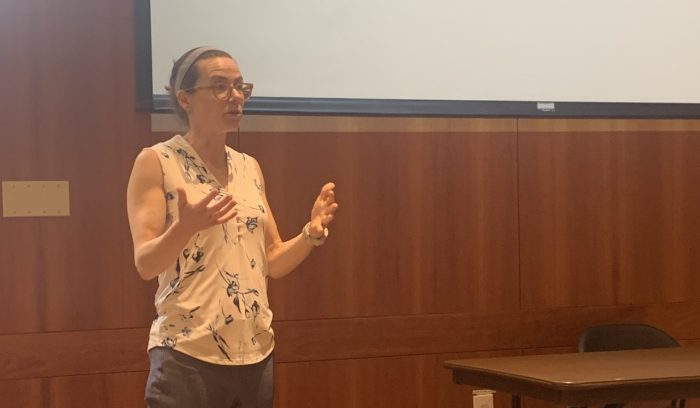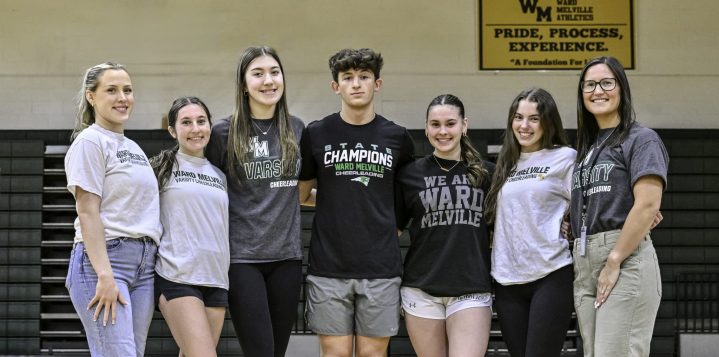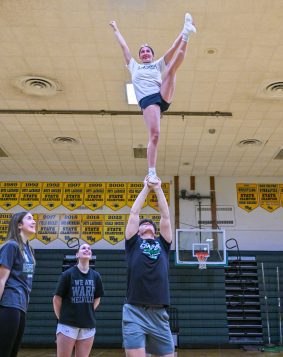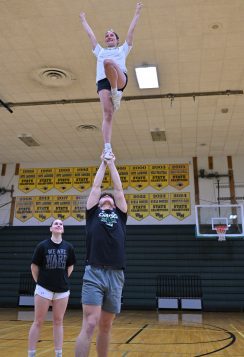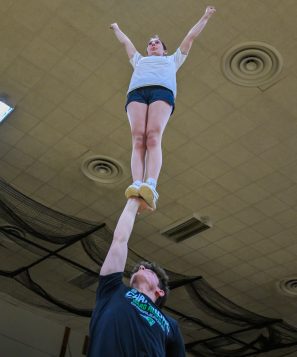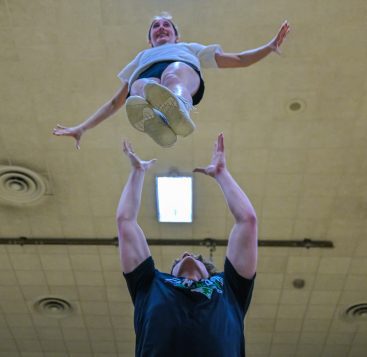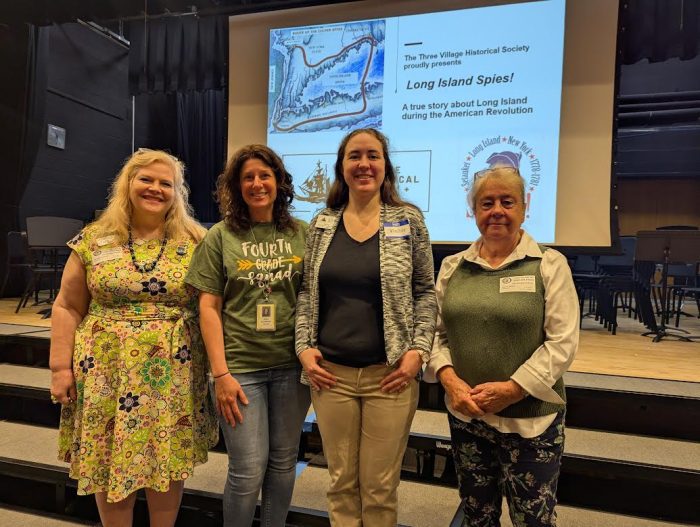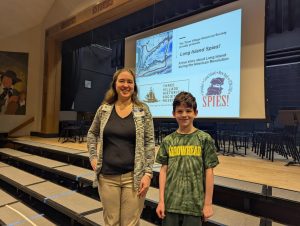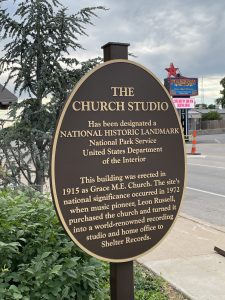By Steven Zaitz
There has been quite a lot to cheer about at Ward Melville High School so far this school year.
Unless you live under a giant, three-cornered hat within the Three Village Central School District, you are probably at least somewhat aware of the ever-lengthening list of athletic achievements Patriots nation has cobbled together so far in 2024-2025.
A third straight New York State title in girls soccer, Long Island championships in both girls and boys volleyball, league titles in cross country, fencing, winter track, girls golf, along with the football team playing for a county chip at Stony Brook, are just some of the headliners for which the green and gold have hoisted up banners in the gym the past few months. With the spring playoffs underway, Ward Melville is looking to add to the list.
Another team — the one that flips and shouts the loudest in support of their fellow champions — that also deserves three cheers for its own success is the Ward Melville cheerleading squad.
Competing across multiple seasons and disciplines, the cheerleading team has earned as much fame and glory as any of these green and gold greats. They have won the last two New York State winter titles for competitive cheerleading, which emphasizes high-skill routines with complex stunting, tumbling and jumping.
They also won the state title in the Game Day Cheer category in the fall of 2024. Game Day Cheer can best be described as what would be performed at a football game, requiring less choreography and acrobatics than Competitive Cheer, but more in the way of crowd engagement. In being the best in New York in both categories, they of course had to first get through the grueling death struggle that is the Long Island high school cheering multiverse.
Not satisfied with local victories, the squad journeyed to the Mecca of competitive cheerleading — the Universal Cheerleaders Association national championships in Orlando, Florida. About 1,000 teams from all over the country swarm Disney every February, and this year the Patriots made it all the way to the finals of the Division I Small School Coed event.
They were edged out for the national title by a fraction of a point by a team from Colorado, and while it was excruciating not to finish at the top of the pyramid, it was still a wildly successful trip and season for the team.
Junior Ian Licavoli is a pillar of the Ward Melville varsity squad in many ways. So much a foundation of the Flying Patriots’ success, Licavoli’s position in cheerleading parlance is called “base.” And what a base he is.
For his efforts and contributions to the team, he was named Newsday’s first team All-Long Island last month. He was the only male cheerleader on that list.
“I started to fall in love with cheerleading around seventh grade and started to really take it seriously in ninth grade,” said Licavoli, who just completed his third year on varsity. “I played Three Village lacrosse and football as a kid but when I started going to open gyms for cheer and I learned how to tumble on my own, everything fell into place. I’m so grateful that it did because cheerleading is such a special sport.”
Ward Melville varsity coach and 2024-2025 Suffolk County Coach of the Year Georgia Curtis is able to harness Licavoli’s talent and thus inject more diversity and excitement into the team’s routine.
“Ian is an amazing athlete,” Curtis said. “Some of the boys on Long Island are able to do one or two of the things that Ian does, but Ian is elite at everything we ask of him and we are so lucky to have him on this team.”
This past year, eight schools on the island participated in coed cheer, a four-fold increase from just two years ago.
In a typical Patriots game day routine, 20 girls will dance, tumble and leap with precise orchestration to the sounds of a recorded marching band as Licavoli weaves between them, shouting “Go Pats, Go” through an oversized bullhorn. Midway through the performance, the music stops and he moves to the center of the formation to meet his longtime friend and flyer, senior Emma Miller.
Effortlessly, Licavoli raises Miller to the sky as if they were both in a zero-gravity chamber, cupping the bottom of her shoes in the palms of his hands as she waves her pom-poms, flashes a touchdown sign and kicks like a Radio City Rockette, just as if she were standing on flat ground. Other formations of flyers flank Licavoli and Miller in groups of two or four, while the shouting and smiling group urges an imaginary football team to score a touchdown.
Curtis and assistant coach and former Patriots cheerleader Maggie Hurley are stationed in front of the mat, beating it with their hands in rhythm with the music, enthusiastically urging the squad as they complete their stunts.
“When this team competes, it is just special,” said Curtis. “People outside the program pull me aside and tell me that, and it really makes me feel good as a coach. But what is also great is how these kids act when they are off the mat. The sportsmanship they have for other teams and the support they have for each other are things you don’t see every day. As a coach, it’s amazing to be a part of.”
Miller, who will cheer at the next level at the University of Delaware, was also named by Newsday as one of the top flyers on the Island. Despite a routine being roughly three minutes on the mat, the hours and hours of practice over many years have helped her and Licavoli to form a bond for success.
“From August to March, we practice six days a week, about three hours a day,” Miller said. “We work really hard to get the chemistry and the trust aspect down pat and I’m super confident in the air and that’s what makes people want to look at you. The confidence I have in myself all comes from my confidence in Ian.”
Traditionally an all-girls sport, especially in the northeast, Licavoli doesn’t consider himself a pioneer or a rebel, despite the potentially divergent perceptions of a boy on the same team as 20 girls, as is the case with the Ward Melville team.
“In the beginning, I suppose being the first boy cheerleader was a little difficult, because our school is so focused on football and lacrosse,” Licavoli said. “It took a little time to get used to, but I just stuck with it because it really is what I love to do and the amount of respect I think I’ve gained from it, the people I have met and the bonds with my teammates — I wouldn’t trade that for anything.”
His teammates are thankful that Licavoli feels this way and rely on him as a pillar of strength on and off the mat.
“Ian just brings so many positive assets to the team with his humor and encouragement,” said teammate Emma Jackson, who is responsible for the important cheer position of back spot. “After a hard practice, he is always going to be there just to lighten everyone’s mood. Everybody on this team is just one big family and Ian meshes into that family very naturally because we all love what we do and love doing it together.”
A member of Licavoli’s other family, his mom Melanie, is proud of how he has pursued the sport that he loves and how it has brought out the best in him.
“I love watching him and what he’s been able to achieve,” Mrs. Licavoli said. “In cheer, you have 2 minutes and 30 seconds to show what you can do and that’s the only chance you get. To watch them as a team deliver great performances consistently, and with Ian being such a leader on the team, it’s amazing and I’m so proud.”
Licavoli, an excellent student who has an eye perhaps toward the medical profession, would love to continue his cheer career at the next level, just as his friend Miller will do.
“I’d love to go to school in Florida to pursue my athletic and academic career,” he said. “There are a lot of schools down there with great cheer programs.”
First, Licavoli has one more year at Ward Melville as a senior, and before he becomes a college student in Florida, he’ll want to make one final business trip to Orlando for nationals in 2026 — and this time finish on top of that pyramid.







